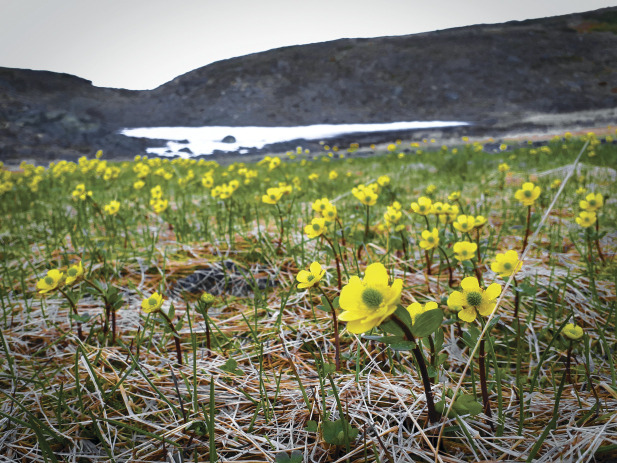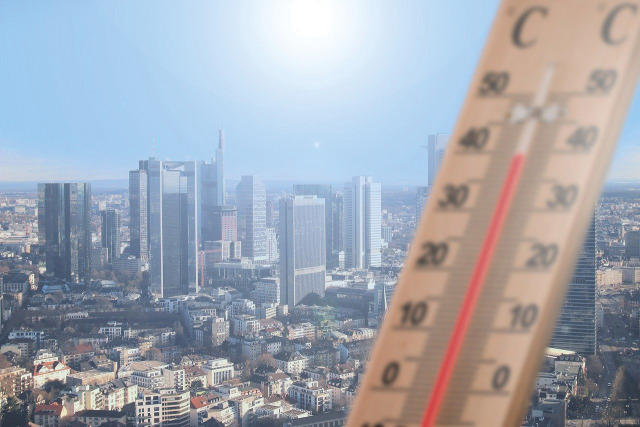Arctic plants and snow cover
Snow buttercup in a meadow.
Arctic tundra faces some of the most rapid climate change, with corresponding consequences for ecosystems. Climate change alters the diversity and distribution of functional traits in ecosystems, but the role of snow cover in functional trait diversity has not been extensively studied. Pekka Niittynen et al. (pp. 21480–21487) observed snow cover and plant diversity in 5,300 Arctic tundra plots of 1 square meter each from satellite imagery. The authors also compiled the functional traits expressed by the plants in the plots and applied machine learning methods to determine the effects of snow cover and temperature on plant functional diversity. Many of the plants’ traits were sensitive to both snow cover and summer temperature; some traits, including leaf nitrogen and phosphorus content and seed mass, were driven by snow cover, whereas others, including leaf area, were driven by temperature. Based on the findings, the authors projected that in a warm climate with long snow-free seasons, tundra plants may become taller and develop bigger leaves than current tundra plants and develop rapid resource-acquisition traits. According to the authors, future modeling of ecosystem function should include the role of snow cover in Arctic tundra biomes. — P.G.
Physician–patient racial concordance and newborn mortality
In the United States, Black infants are significantly more likely to die during childbirth than White infants. However, whether patient–physician racial concordance improves survival outcomes for Black infants remains unclear. To determine the relationship between newborn mortality risk and the attending physician’s race, Brad Greenwood et al. (pp. 21194–21200) reviewed nearly 2 million records of hospital births in Florida that occurred between 1992 and 2015. The authors also retrieved the names of the physicians in charge of the newborns’ care and determined each physician’s race based on publicly searchable photographs. When cared for by White physicians, Black newborns were approximately three times more likely to die in the hospital than White newborns. However, when Black physicians cared for Black newborns, the mortality rate of Black newborns declined between 39 and 58%. This phenomenon was especially evident in cases of challenging births and in hospitals that delivered relatively more Black newborns. However, physician race had little association with the mortality rate of White newborns. The findings suggest that Black physicians outperform their White colleagues when caring for Black newborns, according to the authors. — M.S.
Projected extreme heat and cold exposure in US cities
US cities’ exposure to extreme heat is expected to increase over the next century. Image credit: Pixabay/geralt.
Previous projections of future temperature extremes in the continental United States have not accounted directly for warming due to urban development or its interactions with greenhouse gas (GHG)-induced climate change. Such projections have also defined extremes using a fixed temperature threshold, but threshold temperatures at which excess mortality occurs vary regionally. Ashley Broadbent et al. (pp. 21108–21117) assessed the simultaneous contributions of GHG-induced warming, urban development, and population growth to projected changes in population-weighted exposure to extreme heat and cold in 47 major metropolitan areas in the continental United States across the 21st century. The authors projected that under a high-emissions scenario, population-weighted exposure to locally defined extreme heat would increase by 12.7–29.5 times by the end of the 21st century relative to the beginning of the century, substantially greater than in previous projections. Cities in the US Sunbelt, such as Austin, Miami, and Atlanta, were projected to have the largest relative increases in population heat exposure, driven primarily by simultaneous GHG-induced warming and rapid population growth. The authors also projected a marginal increase in population-weighted cold exposure. The findings could help prioritize urban climate adaptation measures and policy, according to the authors. — B.D.
Sleep and social activity
Sleepiness can impair cognitive ability, motivation, and behavior. However, the effects of sleepiness on social interactions, which play an important role in health and well-being, are unclear. Benjamin Holding et al. (pp. 21209–21217) conducted a study on 641 working adults in Sweden who logged their behavior every 30 minutes, filled out a sleepiness scale every 3 hours, and completed a sleep diary every morning over 3 weeks. Increased sleepiness was tied to a decrease in the probability and duration of social activity, especially on days off and in the evenings. The relationship between social activity and subsequent sleepiness and sleep duration was complex and depended on the time of day. Increased social activity during the late morning and early afternoon was tied to greater sleepiness afterward. Conversely, more social activity in the evening was tied to decreased subsequent sleepiness. Social activity in the afternoon or a few hours in the evening was tied to slightly longer sleep duration the following night, whereas longer bouts of socializing in the evening were associated with a decrease in subsequent sleep duration. Together, the findings suggest that sleepiness is tied to voluntary decreases in social contact. According to the authors, uncovering factors that may interfere with social activity could help address rising rates of loneliness and social isolation. — J.W.
How naming influences infants’ memory of objects
Sample test trial assessing infants’ memory of a previously seen object.
Objects can be identified by using words that denote members of a category or by using individual names. Whether individually naming objects influences infants’ ability to remember them is unclear. Alexander LaTourrette and Sandra Waxman (pp. 21230–21234) analyzed how object naming influences memory in 77 infants who were between 11.5 and 12.5 months of age and recruited from the Greater Chicago area. During a training phase, infants saw four images of different stuffed animals and were randomly assigned to hear either the same name for all animals or different names for each animal. During the test trials, infants viewed each training animal paired with a new animal they had not seen, presented in silence. The authors found that if infants recognized the previously seen training animal, they preferred to look at the new animal. Infants who heard different names for each animal successfully recognized most of the training animals, whereas infants who heard the same name for all animals had difficulty recognizing the training animals. The findings suggest that hearing unique names for objects leads infants to remember individual differences among the objects, according to the authors. — M.S.





